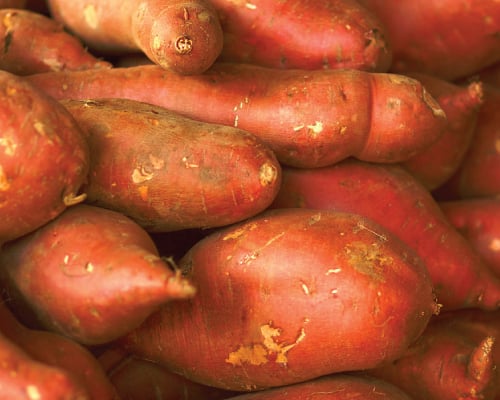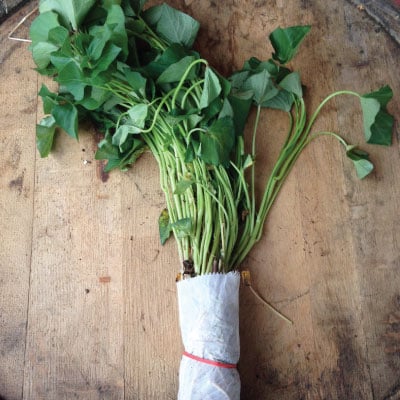
Learning Download: How to Grow Sweet Potatoes
From Seed to Harvest: A guide to growing sweet potatoes.
Sweet potatoes may appear similar to regular potatoes, but unlike regular potatoes which grow best in a cooler environment, sweet potatoes do better in the heat.
To plant:
For those living in warm climates, plant sweet potatoes a month after the last spring frost, as soon as the temperatures outside and the soil temperatures have warmed up considerably. Sweet potatoes aren’t grown fro seeds. They are grown from slips, which are a rooted portion of a mature sweet potato. To obtain a sweet potato slip, cut a sweet potato in half lengthwise and bury each half in damp potting soil. Keep the slips moist and warm, and shoots should sprout within a few days. Leaves will follow the shoots.
However, the slips still aren’t ready to plant into the garden until approximately six weeks after they sprout. Shoots should be between 4 and 8 inches tall before they’re transplanted outside.
When planting your slips, don’t opt for a normal sweet potato from the grocery store. Purchase sweet potatoes form a seed distributer so you know they are free of disease.
When the shoots are old enough, transplant them outside. Since sweet potatoes like it warm, plant the transplants in raised rows, which are usually about 8 inches higher than ground level. This allows the soil to warm quicker early in the season, and raised rows helps the sweet potatoes stay well-drained. To assist in warming the soil even more, spread black plastic along the raised rows. Black plastic should be spread along the rows up to three weeks before planting the sweet potatoes so the soil has plenty of time to warm up.
To plant your shoots, space 8 to 12 inches apart in the raised rows. Plant them 4 inches deep, and leave 3 to 4 feet of space between each sweet potato raw. Some varieties of sweet potatoes are a vining pant, and when the plants grow larger, the vine will take up the space between the rows. Other varieties grow as a bush.
Prior to planting, amend the soil with compost to improve the texture and organic matter. Since sweet potatoes are a root vegetable, they require plenty of air space in the soil to develop their roots.
Plant the sweet potatoes in full sun, but if you live in a dry, hot region, they will tolerate partial shade in the afternoon.
To grow:
Since sweet potato plants are vining, it doesn’t take much time before the vines fill every nook and cranny of your garden, possibly smothering other vegetables or at the least, sucking energy from the sweet potatoes’ growth. To prevent this, gently weed the vines two weeks after you’ve planted the slips. Avoid using a hoe so you don’t disrupt the feeder roots.
Water you sweet potato plants weekly since a regular watering schedule will help prevent the sweet potato skin from splitting. Keep in mind sweet potatoes grow best in soil with a pH of 5.8 and 6.2, but they will also tolerate more acidic soil, such as with a pH as low as 5.0.
To harvest:
Although sweet potatoes are technically considered a perennial plant, specifically in USA Hardiness Zones 8-11, the plants are dug up to harvest the tubers, meaning they are usually grown as an annual vegetable instead. Tubers are ready to harvest when the plant’s foliage turns from green to yellow. The tubers will grow close to the surface, so dig gently when harvesting. If harvesting too roughly, the sweet potato skin will bruise.
What sweet potatoes crave:
While sweet potatoes can crave less-than-satisfactory soil, they will grow a lot better if you utilize fertilizer. To achieve the best effect, add a continuous-release fertilizer containing potassium approximately two weeks after planting the slips. The potassium will be the third number on the fertilizer label. Follow the fertilizer instructions on how to mix it in with the soil. After fertilizing, add biodegradable mulch, such as grass clippings. Continue to add more mulch for another month after fertilizing, but after that, sweet potatoes don’t require more fertilizer.
Instead of adding a potassium-rich fertilizer, another option would be to feed the sweet potato plants with a liquid fertilizer at planting time and again every two weeks as the plants grow.
Where to buy sweet potato slips:
You can find a large variety of certifies sweet potato slips, which means that the slips have been inspected for pests and diseases, at Urban Farmer.
Learning Download: Common pests and diseases: Sweet potatoes
Common pests and diseases: Sweet potatoes
When growing vegetables, it is always exciting to care for the plant throughout its growing phase and then harvest it for delicious recipes later on, but one thing to watch out for is pests and diseases. Different plants are susceptible to different types of pests and diseases, and it is important to make yourself aware so you can keep a watchful eye and also take any preventative methods to keep your plants safe throughout their lifespan.
Sweet potatoes can fall victim to several different pests and diseases.
Pests:
Some of the common pests affecting sweet potatoes include the sweet potato stem borer and the white grub.
The sweet potato borer larvae will bore into the stem of the sweet potato and feed in the crown area. This causes wilting, yellowing and the plant will die. To identify the borers, locate fecal matter on the surface of the soil and holes in the stem of the plant. To manage this problem, keep the garden weed free and use pheromone traps.
The white grub feeds underground on parts of the stem or the roots. The infected plant will wilt and die. To manage this problem, plough deeply in the summer to expose the grub and provide proper drainage.
Diseases:
Common diseases affecting the sweet potato include Alternaria leaf spot, black rot, scab, pox and others.
Alternaria leaf spot causes brown lesions on the leaves with rings. Lesions usually occur on the older leaves. Stems may be affected, too. If the problem is bad enough, defoliation may occur. To prevent this disease, destroy all of the sweet potato residue immediately following harvest and plant resistant sweet potato varieties. Be sure to plant only disease-free seed.
Black rot causes stunted plants, wilting plants, plants that will become yellow and other symptoms. Plants may drop leaves and they may die. There will be circular brown-black spots on the tubers. To prevent this disease, only use disease-free seed. Practice good crop rotation and treat the seeds with appropriate fungicides prior to planting.
Scab causes small brown lesions on the leaf and stem veins which will then become corky in textured. Veins will shrink and the leaves will curl. Lesions on the stems will be slightly raised. To prevent this disease, avoid using overhead irrigation, destroy all crop residue immediately after harvest, and apply appropriate fungicides.
Pox will cause poor plant growth and a reduced yield. Corky lesions will be in a V shape on the tubers. To prevent this, use resistant varieties of sweet potatoes. Maintain a low pH in the soil and practice good crop rotation. You can also utilize fumigation of the soil prior to planting.


